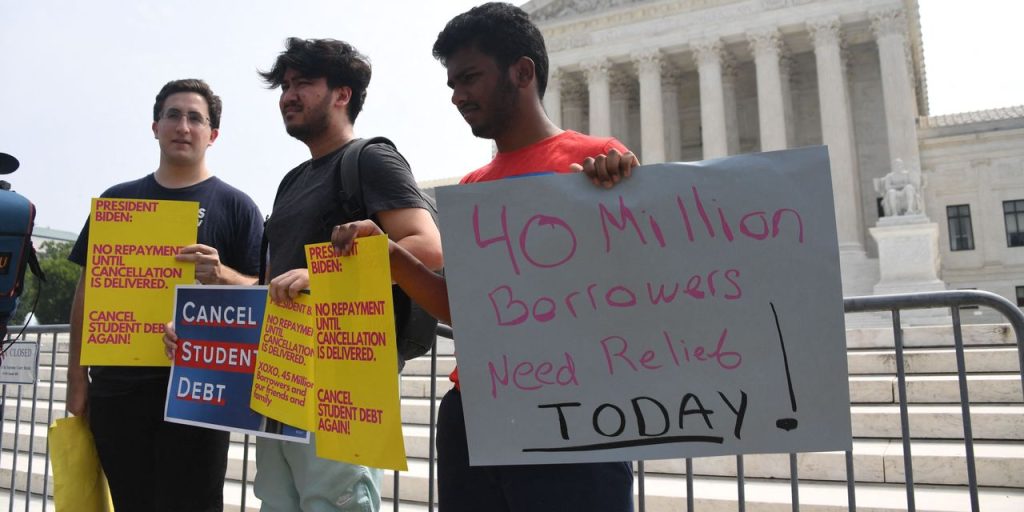The resumption of federal student-loan payments this month after a more than a three-year pause, likely won’t be a major hit to the economy overall, but certain groups of borrowers may struggle to make their student-debt payments or pay down other loans.
Those are some of the findings of a survey released by the Federal Reserve Bank of New York on Wednesday. Economists at the New York Fed wrote in a blog post expanding on the findings that they expect the end of the student-loan payment freeze to result in a 0.1 point reduction in aggregate monthly spending as compared to August 2023. On average, borrowers reported that the resumption of student-loan payments would push them to cut back by about $56 per month.
Borrowers’ spending decline may be relatively modest for a few reasons, according to the New York Fed. For one, borrowers may have already started adjusting their spending patterns ahead of payments resuming. Deposits from the Department of Education to the U.S. Treasury Department, the bulk of which are federal student loan payments, increased after the Supreme Court struck down the Biden administration’s plan for broad based student-debt relief and continued to rise ahead of interest resuming on student loans in September.
New repayment plans that allow borrowers to devote less of their income to student-loan payments may also explain part of the limited hit to spending, the New York Fed said. In addition, borrowers may decide to dip into savings in order to make their student loan payments, the New York Fed said, which would blunt the impact on spending. Indeed, the payment pause afforded borrowers $260 billion over the past three years to save and spend.
The New York Fed’s findings come as borrowers are paying their student-loan bills for the first time in three years this month. Some analyses have also indicated that the end of the pandemic-era freeze wouldn’t have a huge impact on the economy. Still others have suggested it would result in a bigger hit to consumer spending. Some analysts have said the return of payments could impact retailers’ bottom lines.
In addition, history and other research indicates borrowers may struggle. When borrowers resumed payments after smaller, more limited pauses there were elevated rates of delinquency and default. Nearly 8% of student-loan borrowers were behind on other payment obligations and roughly 20% of borrowers had risk factors that suggested they would struggle when payments resumed, according to research from the Consumer Financial Protection Bureau released in June.
The New York Fed survey did indicate that certain borrowers will struggle. Borrowers who had loans paused during the pandemic put the chance they would miss a student loan payment at nearly 23% on average, the survey found.
The risk of missing a payment was especially acute among certain groups. Women put the likelihood they would miss a payment at 28.9% ,compared to 12.5% for men. Low-income borrowers, or those with a household income of less than $60,000, reported an average probability of missing a payment at nearly 39% compared with 14.3% for borrowers in households earning more than $60,000.
Borrowers who miss payments will avoid the worst consequences of student-loan delinquency and default thanks to a grace period that goes through the fall of 2024. Still, student-loan payments could put borrowers at risk of missing payments on other debt obligations, the New York Fed found. On average, borrowers reported an 11.8% increase in the chance they’d miss another loan payment due to repaying student loans.
The authors of the New York Fed post suggested that the SAVE plan, a payment plan launched by the Biden administration earlier this year, could help insulate some borrowers from the challenges of making student-loan payments. Under this plan borrowers repay their debt as a percentage of their income and have the remainder discharged after a certain number of years of payments. While these so-called income driven plans have existed for decades, SAVE protects the most income.
Roughly one-fifth of borrowers who were in a standard repayment plan — or a plan where you pay off the debt in 10 years similar to a mortgage — planned to enroll in an income-driven plan, according to the New York Fed. In addition, about 78% of borrowers repaying their student debt for the first time planned to enroll in one. That would push the share of borrowers using income-driven repayment to 58%, up from about 50% pre-pandemic, the New York Fed found.
But in order for that uptick to materialize borrowers will have to successfully enroll in the plans. Over the past several weeks, borrowers preparing for payments to resume have struggled to access the benefits of the student-loan program. Many have waited on hold for hours to talk to their servicers, others have received incorrect payment information and still others who were promised debt cancellation by the government still didn’t have the debt cleared by the time payments resumed this month.
Read the full article here
